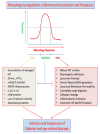The Role of Txnip in Mitophagy Dysregulation and Inflammasome Activation in Diabetic Retinopathy: A New Perspective
- PMID: 29376145
- PMCID: PMC5786434
- DOI: 10.19080/jojo.2017.04.555643
The Role of Txnip in Mitophagy Dysregulation and Inflammasome Activation in Diabetic Retinopathy: A New Perspective
Abstract
Mitochondria are responsible for bioenergetics, metabolism and apoptosis signals in health and disease. The retina being a part of the central nervous system consumes large amounts of glucose and oxygen to generate ATP via the mitochondrial oxidative phosphorylation for its phototransduction and visual function. During ATP generation, electrons leak from the mitochondrial electron transport chain, which is captured by molecular oxygen to produce reactive oxygen species (ROS). These mtROS damage mitochondrial proteins, mtDNA, and membrane lipids and release them in the cytosol. Mitochondrial components are recognized as danger-associated molecular patterns (DAMPS) by cytosolic pattern recognition receptors such as NOD-like receptors, NLRP3 inflammasomes. They process pro-caspase-1 to active caspase-1, which cleaves pro-inflammatory IL-1β o mature IL-1β causing inflammation and cell death by pyroptosis. To counter the damaging action of mtROS and inflammasomes in fully differentiated cells in the retina, the removal of the damaged and dysfunctional mitochondria by a double-membrane autophagic process via lysosomal degradation called mitophagy is critical for mitochondrial homeostasis and cell survival. Nonetheless, under chronic diseases including diabetic retinopathy (DR), mitophagy dysregulation and NLRP3 inflammasome activation exist, which cause premature cell death and disease progression. Recently, the thioredoxin-interacting protein TXNIP, which is strongly induced by diabetes and inhibits anti-oxidant function of thioredoxin, has been implicated in mitochondrial dysfunction, mitophagic dysregulation and NLRP3 inflammasome activation in DR. Therefore, TXNIP silencing or pharmacological inhibition may normalize mitophagic flux and NLRP3 inflammasome activation, which will prevent or slow down the progression of DR.
Keywords: Diabetic retinopathy; Mitophagy; NLRP3 inflammasome; TXNIP; mt-Keima.
Figures
Similar articles
-
Mitophagic Flux Deregulation, Lysosomal Destabilization and NLRP3 Inflammasome Activation in Diabetic Retinopathy: Potentials of Gene Therapy Targeting TXNIP and The Redox System.Ophthalmol Res Rep. 2018;3(1):ORRT-126. Epub 2018 Mar 12. Ophthalmol Res Rep. 2018. PMID: 31355373 Free PMC article.
-
Optineurin inhibits NLRP3 inflammasome activation by enhancing mitophagy of renal tubular cells in diabetic nephropathy.FASEB J. 2019 Mar;33(3):4571-4585. doi: 10.1096/fj.201801749RRR. Epub 2018 Dec 20. FASEB J. 2019. PMID: 30571313
-
Activation of the TXNIP/NLRP3 inflammasome pathway contributes to inflammation in diabetic retinopathy: a novel inhibitory effect of minocycline.Inflamm Res. 2017 Feb;66(2):157-166. doi: 10.1007/s00011-016-1002-6. Epub 2016 Oct 26. Inflamm Res. 2017. PMID: 27785530
-
Ambiguities in NLRP3 inflammasome regulation: is there a role for mitochondria?Biochim Biophys Acta. 2014 Apr;1840(4):1433-40. doi: 10.1016/j.bbagen.2013.08.014. Epub 2013 Aug 27. Biochim Biophys Acta. 2014. PMID: 23994495 Review.
-
Mitophagy: a balance regulator of NLRP3 inflammasome activation.BMB Rep. 2016 Oct;49(10):529-535. doi: 10.5483/bmbrep.2016.49.10.115. BMB Rep. 2016. PMID: 27439607 Free PMC article. Review.
Cited by
-
Damage-Associated Molecular Patterns (DAMPs) in Retinal Disorders.Int J Mol Sci. 2022 Feb 26;23(5):2591. doi: 10.3390/ijms23052591. Int J Mol Sci. 2022. PMID: 35269741 Free PMC article. Review.
-
Role of Takeda G protein‑coupled receptor 5 in microvascular endothelial cell dysfunction in diabetic retinopathy (Review).Exp Ther Med. 2022 Sep 15;24(5):674. doi: 10.3892/etm.2022.11610. eCollection 2022 Nov. Exp Ther Med. 2022. PMID: 36237599 Free PMC article. Review.
-
Thioredoxin-interacting protein in diabetic retinal neurodegeneration: A novel potential therapeutic target for diabetic retinopathy.Front Neurosci. 2022 Aug 9;16:957667. doi: 10.3389/fnins.2022.957667. eCollection 2022. Front Neurosci. 2022. PMID: 36017183 Free PMC article. Review.
-
Metabolic Dysregulation and Neurovascular Dysfunction in Diabetic Retinopathy.Antioxidants (Basel). 2020 Dec 8;9(12):1244. doi: 10.3390/antiox9121244. Antioxidants (Basel). 2020. PMID: 33302369 Free PMC article. Review.
-
Mitochondrial Stability in Diabetic Retinopathy: Lessons Learned From Epigenetics.Diabetes. 2019 Feb;68(2):241-247. doi: 10.2337/dbi18-0016. Diabetes. 2019. PMID: 30665952 Free PMC article. Review.
References
-
- Wong TY, Cheung CM, Larsen M, Sharma S, Simó R. Diabetic retinopathy. Nat Rev Dis Primers. 2016;2:16012. - PubMed
Grants and funding
LinkOut - more resources
Full Text Sources
Other Literature Sources



